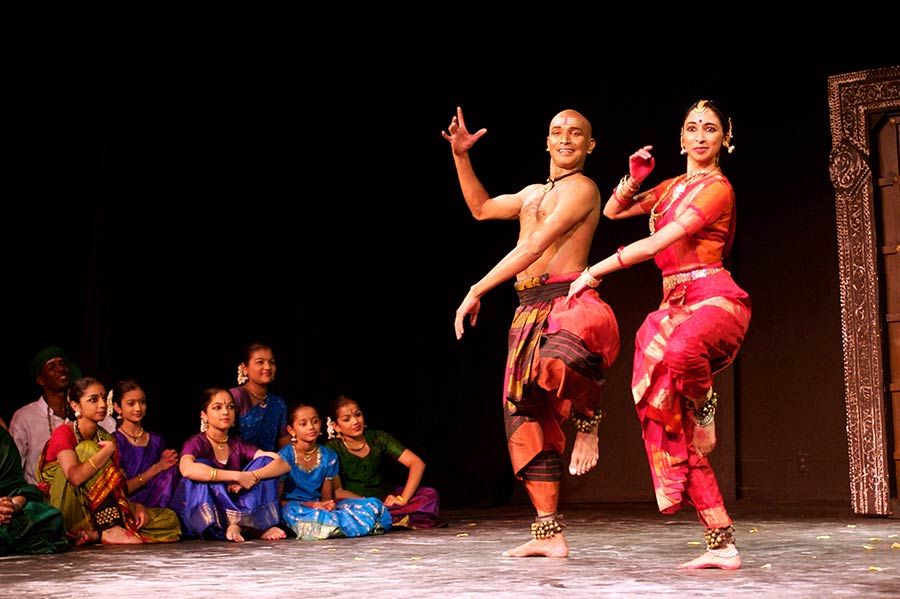
Patanjali Dance Performance (photo by Nick Barral)
Editor's note: Malathi Iyengar is a Los Angeles based choreographer, dancer, teacher, writer, and visual artist. Iyengar holds a Master of Fine Arts degree in Choreography and Performance from University of California, Los Angeles, has studied Bharatanatyam (classical dance of India) with guru Narmada of Bangalore, India and choreography and improvisation under the mentorship of Marion Scott.
Iyengar is the artistic director of the Rangoli Dance Company & Rangoli Foundation for Art & Culture, which was founded in 1985.
Her creations reflect a wide range of artistic expressions ranging from traditional works to inter-cultural collaborations with artists of diverse cultures. Her critically acclaimed works include 'Shivaya', 'Patanjali', 'Kodhai's Dream', 'Punyakoti', 'Tulasi', 'Sacred Geometry', 'Love Lyrics', 'Ramayana', 'Mustard Seeds', & 'Creation Myth'.
Click here to watch videos of dance performances choreographed by Malathi in Sutra Journal
Lea Horvatic:
What are the main styles of Indian classical dance? What is your chosen style and how does it differ from the others?
Malathi Iyengar:
There are eight known classical forms of Indian classical dance.
I practice and teach Bharatanatyam, classical dance form from south India. Bharatanatyam is one of the oldest and most popular dance forms in the world
today. The antiquity of Bharatanatyam has been traced to several manuscripts including Natya Shastra (speculated to be at least 2000 years old)
written by Bharata Muni, a comprehensive treatise on the performing arts of India. Bharatanatyam once danced within the temple precincts, moved to the
proscenium in the early part of 20th century. The technique and dance style of Bharatanatyam has been evolving continuously over centuries.
Bharatanatyam is generally accompanied by Karnatic music, classical music of south India. Bhava (expression), Raga (melody), Tala (rhythm) are some of the basic elements of this dance form. The three main aspects of Bharatanatyam are: Nritta (pure dance movement
with no interpretive meaning), Nritya (combination of rhythm, intricate hand gestures, expressions, narratives, facial and eye movements), and Natya (element of drama and storytelling).
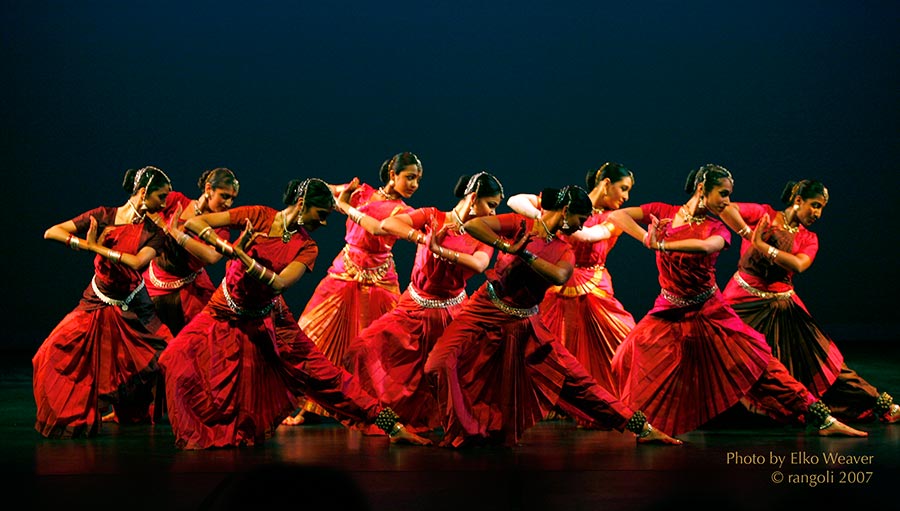
Rangoli Dance Company
Lea Horvatic:
Was the world of dance always an obvious choice? Describe your teaching lineage, familial or otherwise.
Malathi Iyengar:
I embraced dance relatively late in my life. I liked the artistic discipline, and practising it was a spiritual experience. The form seemed to encompass
movement, music, sculpture, painting, language, stories, and this creative path felt right to me.
I come from a family of artists and musicians. My parents Sharada and Venkatachalan were actively involved in not only pursuing their own training in vocal
music and the violin, but were also key figures in organizing music concerts, religious discourses for holy days and other community events in a small
village called Soladevanahalli (near Hesaraghatta, home of Nrityagram) in Bangalore, India. Though they had little means, they conducted two-week long
festivals with the help of a few members who had the similar passion for classical art forms. My father was also the Secretary for four years and was
responsible for all aspects of organizing events. They continued the tradition for almost 20 years between 1955-1975. As children, my brother Sudarshan and
myself immersed ourselves in these festivities. Thus the seeds were sown for nurturing our rich cultural heritage.
During these times, I learned, practiced, and honed my skills as a visual artist. I indulged in painting, drawing, and was prolific in creating the sacred
floor designs and mandalas called ‘Rangoli’. The art of Rangoli is executed purely as an offering to the Gods along with flowers, fruits, and candles. The
ritual of drawing Rangoli patterns, a skill handed down from mother to daughter, is considered an auspicious welcome sign. Women start their daily chores
by drawing Rangoli designs in front of the threshold, in prayer area, courtyards, walls, and in front of the sacred plant Tulasi. Drawn meticulously and
with bare fingers, it is meant to ward off all evils, and is revered as a divine art. Rangoli involves drawing on the floor and it’s usually done using
rice flour, chalk, fine quartz powder, flower petals, grains, or natural vegetable dyes. In India, the antiquity of Rangoli symbolizes Beauty, Hope and
Tradition.
Hence my artistic endeavors took the name Rangoli Foundation for Art & Culture in 1985. Around 1988, a strong concern to introduce our then 6
year old daughter Lakshmi to Indian culture and art turned out to be a very involved process of finding a master teacher in India, and eventually both of
us started vigorously pursuing Bharatanatyam dance. I performed my solo dance debut in 1992 when I was 38 years old, and Lakshmi in 1993 aged 11. All along
the pillar of strength was my husband Suresh Iyengar, as well as my guru Narmada and my parents. I felt the addition of dance, as a component in my life
and also for expansion of Rangoli activities was a natural transition and growth. Rangoli Dance Company was formed in 1992 and it comprised of my
senior students and guest artists from India.
My artistic Lineage is known as ‘Pandanallur/Tanjore’. From my Guru to hers, it stretches into past like this:
-
Malathi Iyengar, disciple of Guru Narmada (1942 – 2007), Bangalore, Karnataka, India
-
Guru Narmada, disciple of Guru Kittappa Pillai (1913 – 1999), Tanjore, Tamil Nadu, India
-
Guru Kittappa Pillai, direct descendant of the Tanjore Quartet (19th century), Tamil Nadu, India
-
Guru Narmada, herself a recipient of many prestigious national and state awards, encouraged her disciples to retain individuality and creative freedom
within the classical guidelines.
-
Guru Kittappa Pillai’s artistic lineage was rich with maternal grandfather being ‘Pandanallur Meenakshisundaram Pillai’ and paternal ancestors being the
legendary music and dance masters, the Tanjore Quartet, the four brothers, Chinnaiah, Ponnaiah, Shivanandam and Vadivelu.
-
The exceptionally gifted brothers of Tanjore Quartet were heirs to a very rich oral tradition in classical music and dance. They are responsible
for present day Bharatanatyam format called the ‘Margam‘, and were much sought after teachers by the temples and royal courts of Tanjore (Tamil Nadu),
Mysore (Karnataka), and Kerala.
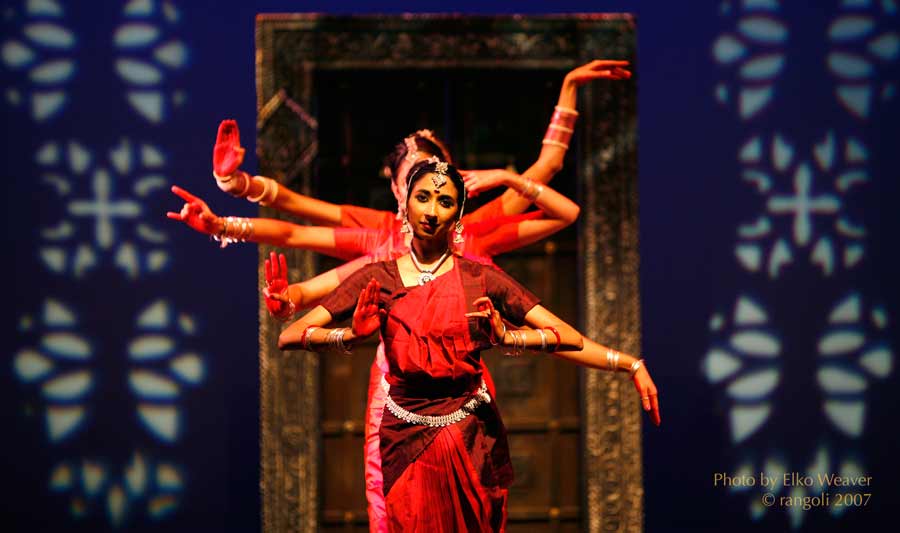
Rangoli Dance Company
Lea Horvatic:
What were the phases of training you had to go through before you were deemed ready to strike out on your own as an independent danseuse?
Malathi Iyengar:
My guru Narmada travelled from Bangalore to Los Angeles twice a year for almost 8 years to train me, and our daughter Lakshmi. I trained 8-9 hours a day,
learning the fundamental steps, phrases, gestures, expression, sequences, and dances. The process was intense and very fulfilling. Our daughter studied and
practiced dancing each day after school and on weekends. I also travelled to India each year to further my skills and studies in dance and music. It was my
guru who encouraged me to teach, perform, and present. She was generous and wanted the tradition to continue.
This process inspired me to return to University of California, Los Angeles to earn a Masters in Fine Arts in Choreography.
Lea Horvatic:
How does modern dance in the West differ from the classical Indian approach? Is there room for innovation within the Indian traditions?
Malathi Iyengar:
Navigating the cultural freeway of Los Angeles has forced me to evolve, to ask questions of my culture, my identity, myself. How do I orient my identity on
a changing cultural map? How do I navigate within the West when my soul is in the East? What is my evolutionary journey?
We are in a world where the daily obsession seems to be, 'What’s new and what’s next?' It’s easy to become very distracted by this. I feel it is important
for me to be grounded in the traditional before I think of new ways of presenting works. To me it is a rare and welcome reminder that true classical art is
timeless.
In the Indian aesthetic we have Rasa, which is a very beautiful thing. With no proper definition, but just a loose one, it can be described as an aesthetic
experience felt by the perceiver and performer. So when the perceiver and the performer connect, that is when the Rasa is established. Meaning the
aesthetic experience is established. When that experience is established, you will probably go home in tears, because you saw a wonderful play that day.
The increasing complexity of today's new dances shows itself in the choreography in a number of ways. There is the choreographers’ fascination with group
dynamics, numbers and spatial relationships. New, fractional, and diagonal sequences are being incorporated into the dances. New dances contain more and
shorter passages than the older traditional dances, which consist of fewer and longer sequences. There are now more intricate combinations of moves, often
danced somewhat faster than the older ones were. The dancers occupy a greater number of different positions and see more new faces in the course of a
single repetition of a dance. Dancers may be separated from one another during a phrase, to be reunited at some point later. The transitions, as they have
become smoother, have also become more precise, often requiring closer timing
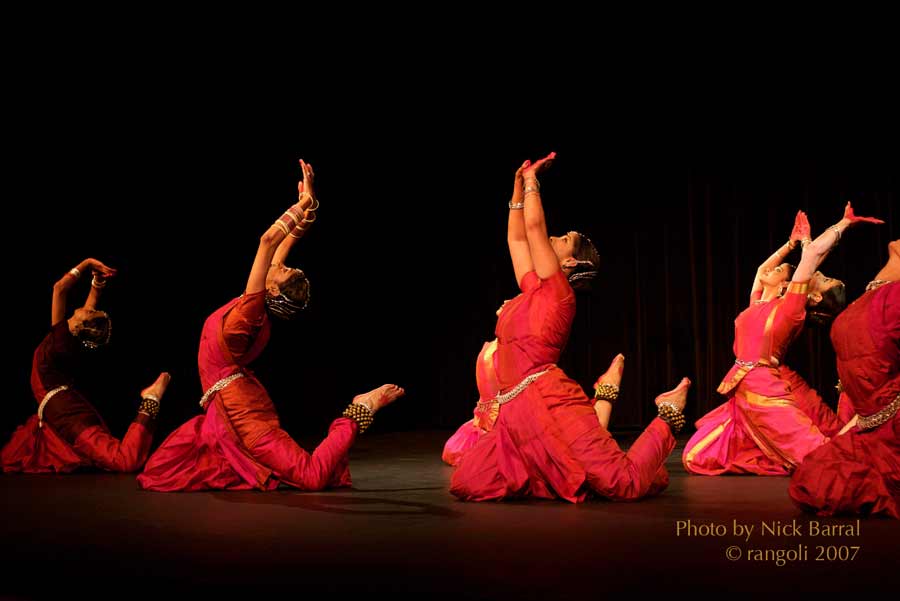
Rangoli Dance Company
Lea Horvatic:
Please describe some of your most memorable performances and choreographed work. Give us an insight into your creative process - what goes into the making
of a Malathi Iyengar show?
Malathi Iyengar:
It is always gratifying to know that the audience enjoyed and connected with our presentation. Although this is difficult to accomplish, it is important
for me not to take our audience for granted, but to strive to touch them all individually on that level.
I have been particularly satisfied with some of my choreographic works:
-
Love Trajectory (2013),
-
Shivaya (2010),
-
Patanjali (2007),
-
Kodhai’s Dream (2006),
-
Punyakoti (2004), and
-
Sacred Geometry (2002)
As Artistic Director of Rangoli Dance Company for 30 years, I’ve rigorously pursued Bharatanatyam dance not as a static museum artifact, but as an evolving
art form that is accessible to everyone. As you know, the traditional, ever-popular Bharatanatyam dance form began over 2,000 years ago. It tells the
myths, legends, and love stories of Indian culture. In India, the antiquity of the visual art 'Rangoli', symbolizes Beauty, Hope, and Tradition. Using all
of this as a foundation, my curiosity in cross-cultural choreography, yoga, modern dance, and the physicality of daily life, propels the company’s
trajectory towards dance that is universal in story, meaning, and impact. We creatively engage in a collaborative artistic process in dance, music, theater
and visual arts.
So, in practice, how does this work? Giving serious consideration to two central factors helps me to create: my Intent and my Audience. Inspiration, the
creative urge, ignites these factors. Inspiration alludes to inner whisperings. If I am listening well and acting clearly, my work will contain the
resonance of that inspiration which prompted the work in the first place. Within this context, I am always looking to answer fundamental choreographic
questions: How do I sustain and focus the attention span of an audience? How can I refine an idea down to its core essence? How does a dance's structure
determine its ‘story’? How does timing affect meaning? I may finally believe that I have researched an idea, have all the facts to support it, and feel
passionate about the process and the outcome. But is that enough to guarantee a vital connection with an audience? To win people’s hearts?
Very often, we think our passion for what we believe will carry us through, but we don't realize that this passion may not really matter to the person we
are presenting to. One should always be cautious of wanting to persuade others to agree with or enjoy your creative work. I often will launch into why I
feel a particular dance work is a wonderful idea. I guess it is that instinctual need we all have to validate our life experiences with others. But it’s
wise to assume that people may not understand, or even enjoy what I may want to present. I feel knowing this is the key to a successful presentation,
because it maintains my objectivity, and my ability to be flexible. To share our ideas we must understand our audience. Listen. Ask questions. Without an
audience, our partner in any dance event, there is no electricity, no aesthetic experience.
I’ve found that dances that reflect myths and legends with morals attract a specific audience and are not always practical for mainstream audiences in the
West. The majority of people do not understand the stories, hand gestures, and narratives from India. When I choose to work on story-based choreography
like excerpts from our legends (Ramayana or Mahabharatha), I select stories that have relevance to the present, and keep the storytelling very simple,
direct, and brief. I stage and present them in a new manner so it does not stay as a relic or a museum piece.
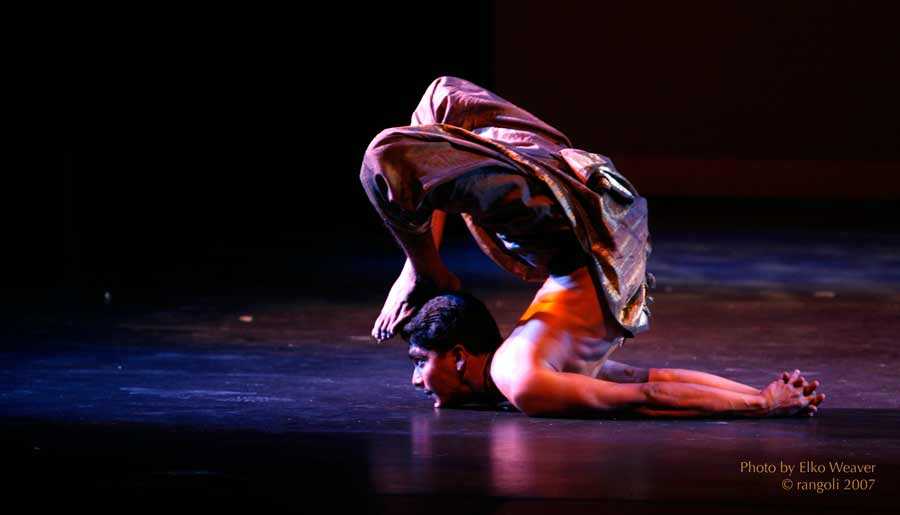
Rangoli Dance Company
Lea Horvatic:
How did the Patanjali show come about? Please describe your rendering of Patanjali. Where do Yoga and Bharatanatyam intersect?
Malathi Iyengar:
I was always interested to know more about the connections between Yoga and Indian classical dance. I researched, read, and talked to scholars about this
particular connection. This eventually led me to conceive a dance performance that would integrate movement, music, visuals, and Yoga.
Patanjali
, a thematic dance concert, explored the unique and powerful relationship between Yoga and dance. Historians say that Patanjali lived in India around two
thousand years ago. According to legend, Patanjali is none other than Aadishehsa, the cosmic serpent upon which the Hindu lord Vishnu reclines. Endowed
with a body that is half human and half serpent, Patanjali became an ardent devotee of Lord Shiva. Though Yoga existed much before Patanjali’s time, he
documented what had until that time been handed down by means of oral tradition from master to pupil. The legends say that Yoga, classical dance forms such
as Bharatanatyam, and martial arts like Kalari evolved from Lord Shiva’s cosmic dance of bliss. Yoga, meaning integration, combines ancient spiritual
practices with mind-body techniques. Yoga is respected as a science, an art form, and a philosophy of life. Patanjali, a thematic dance concert,
explores the unique and powerful relationship between Yoga and dance. The dance performance featured popular legends related to sage Patanjali, the cosmic
dance of Shiva, and the holy city of Chidambaram in India.
Dr Christopher Key Chapple opened the concert with a scholarly introduction to Patanjali.
Dr Suresh Iyengar created set design and sculpture of Shivalingam for the performance.
Lea Horvatic:
Outside of your specialty, what are some of the other dance traditions and performances you have admired?
Malathi Iyengar:
I admire and am inspired by many other artistic traditions including Modern Dance, Opera, Music, Visual Arts and Theatre. Some of the performances I have
appreciated include:
-
Sacred Monsters, dance concert by Sylvie Guillem and Akram Khan
-
Gianni Schicchi & Pagliacci, Los Angeles Opera
-
Salome (Al Pacino as King Herod)
-
Neil Diamond, live concert/performance of Hot August Night at the Greek Theatre, LA
-
Kelucharan Mohapatra (Odissi Performance)
Click here to watch videos of dance performances choreographed by Malathi in Sutra Journal